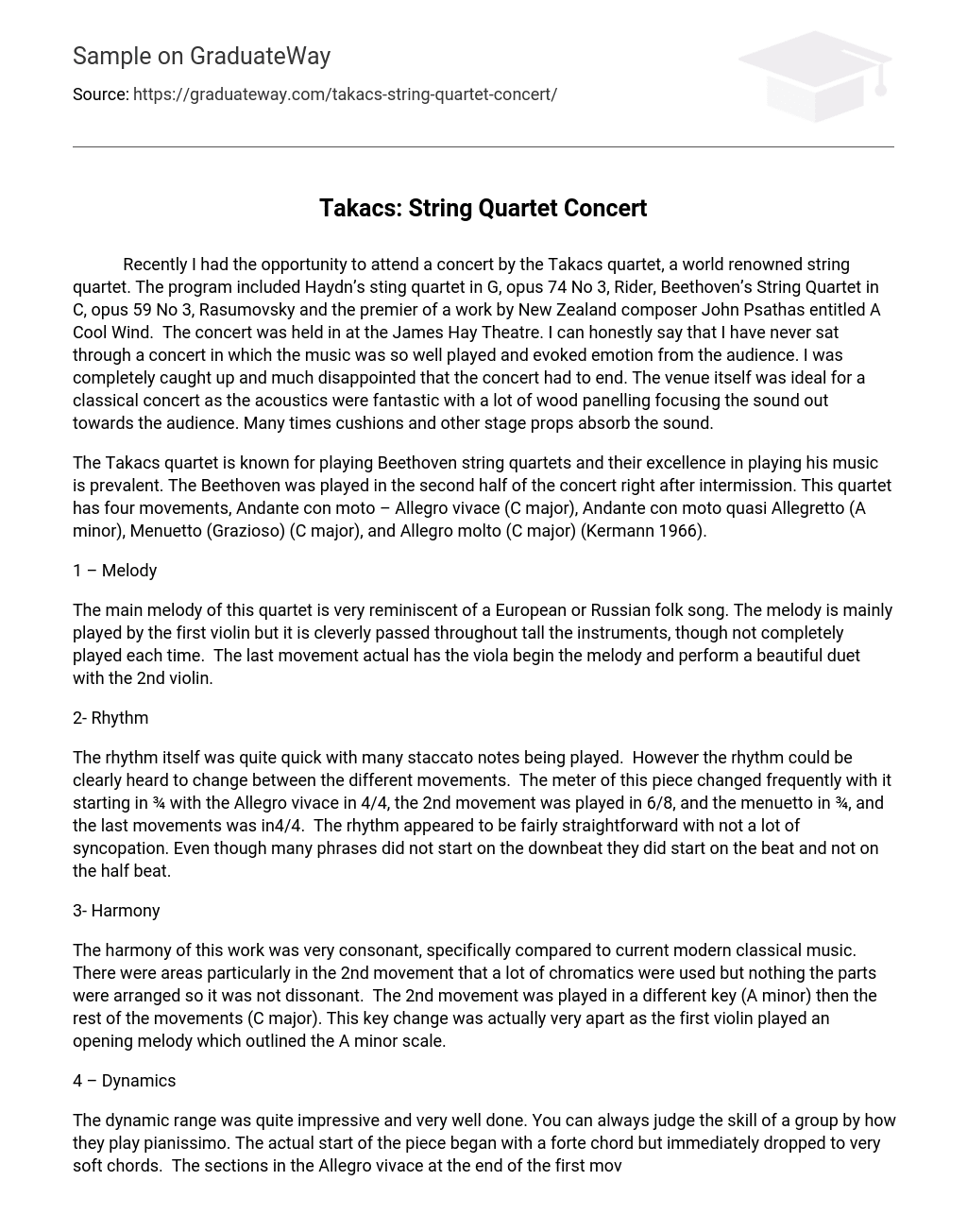Recently I had the opportunity to attend a concert by the Takacs quartet, a world renowned string quartet. The program included Haydn’s sting quartet in G, opus 74 No 3, Rider, Beethoven’s String Quartet in C, opus 59 No 3, Rasumovsky and the premier of a work by New Zealand composer John Psathas entitled A Cool Wind. The concert was held in at the James Hay Theatre. I can honestly say that I have never sat through a concert in which the music was so well played and evoked emotion from the audience. I was completely caught up and much disappointed that the concert had to end. The venue itself was ideal for a classical concert as the acoustics were fantastic with a lot of wood panelling focusing the sound out towards the audience. Many times cushions and other stage props absorb the sound.
The Takacs quartet is known for playing Beethoven string quartets and their excellence in playing his music is prevalent. The Beethoven was played in the second half of the concert right after intermission. This quartet has four movements, Andante con moto – Allegro vivace (C major), Andante con moto quasi Allegretto (A minor), Menuetto (Grazioso) (C major), and Allegro molto (C major) (Kermann 1966).
1 – Melody
The main melody of this quartet is very reminiscent of a European or Russian folk song. The melody is mainly played by the first violin but it is cleverly passed throughout tall the instruments, though not completely played each time. The last movement actual has the viola begin the melody and perform a beautiful duet with the 2nd violin.
2- Rhythm
The rhythm itself was quite quick with many staccato notes being played. However the rhythm could be clearly heard to change between the different movements. The meter of this piece changed frequently with it starting in ¾ with the Allegro vivace in 4/4, the 2nd movement was played in 6/8, and the menuetto in ¾, and the last movements was in4/4. The rhythm appeared to be fairly straightforward with not a lot of syncopation. Even though many phrases did not start on the downbeat they did start on the beat and not on the half beat.
3- Harmony
The harmony of this work was very consonant, specifically compared to current modern classical music. There were areas particularly in the 2nd movement that a lot of chromatics were used but nothing the parts were arranged so it was not dissonant. The 2nd movement was played in a different key (A minor) then the rest of the movements (C major). This key change was actually very apart as the first violin played an opening melody which outlined the A minor scale.
4 – Dynamics
The dynamic range was quite impressive and very well done. You can always judge the skill of a group by how they play pianissimo. The actual start of the piece began with a forte chord but immediately dropped to very soft chords. The sections in the Allegro vivace at the end of the first movement where the two violins play together and the viola and cello play together but syncopated with the violins was extremely loud, which made a statement as the notes were much longer then the majority of that entire movement. The dynamics changed extensively throughout all the movements so not one dynamic dominated a movement but the changes were very clear as most of the piece alternated between forte and piano.
5 – Timbre
There were only string instruments as it was a string quartet but the different devices used produced some very different timbres. The first violin general plays much of the higher notes and these notes do tend to cut through all other noise. The cellos resonance was gorgeous and just stretched the low notes out. It very much reminded be of aged whiskey, something very mellow and old. All the instruments blended so very well that if you new nothing about instruments you might have thought it was the same person playing everything, or one instrument producing all of those different sounds.
References:
Kermann, J., The Beethoven Quartets, W.W. Norton & Co, New York, (1966)





